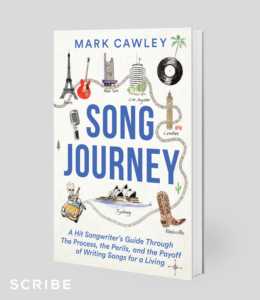What’s the difference between a good book cover and a great one?
It’s not an easy question to answer.
But most people know the difference when they see it.
Why?
Because great book covers start up an instant and visual conversation with readers, telling them:
- What the book is about
- How professionally it’s put together
- Who the book is for
- What they’ll get out of it
The first two points are common to every book, and a good (but not great) book cover stops with these. It offers up a solid title and a professional, well-balanced design, but it doesn’t stand out in the crowd.
A great cover, on the other hand, is micro-targeted to the perfect audience for that book. It grabs their attention and screams, “You need this!” from the moment it catches their eye.
So, how does it do that? Is there a formula for creating a truly great book cover?
Well, yes and no.
There’s no precise formula for the kind of art, design, or style that makes a great cover. Great covers can use original illustration and photography, stock images, or typography alone.
But every great cover tells a story, and each one has a distinct personality.
So, if you’re thinking about a book cover and wondering where to find stock images or photos, start by taking a step back and deciding exactly what you need.
Because the real key to a great cover is designing it with purpose–to send the right message to the right audience.
6 Great Book Covers (With and Without Stock Images)
Many Authors assume they need stock illustrations or photography for their covers. But it’s a mistake to start looking at a bunch of stock images for inspiration before you have any idea what you want.
Decide on a cover direction first. Then decide where to get what you need.
The following 6 covers demonstrate a wide range of options, all fantastic. They use stock images, original illustrations, a dedicated photo shoot, and a typography-based cover with no stock imagery at all.
1. Naked at Work, by Danessa Knaupp

This cover is a great example of the kind of imagery that can complement a title, giving it direction and emotional context.
The full book title is Naked at Work: A Leader’s Guide to Fearless Authenticity. The very idea of being naked at work raises feelings of anxiety, but the subtitle uses words like Leader and Fearless to provide contradiction.
The designer has captured this tension beautifully. The overall feel of the cover is naked, yes, but not cold.
The white background and black, lowercase, wide-spaced lettering all suggest naked simplicity. In contrast, the orange provides warmth—with color that flows from a lighter orange at the top into the darker orange of the Author’s name.
The orange itself is partially peeled, again implying nakedness. But a naked orange is inviting, not frightening. So the entire design suggests that “nakedness,” as the Author means it, is not something to be afraid of. Rather, you should embrace it.
The shadow gives the cover further depth, inviting the reader in. The curling peel implies a hint of playfulness.
All of that emotional complexity is provided by a single stock image of an orange in combination with some smart typographic design.
2. Song Journey, by Mark Cawley

Song Journey, by Mark Cawley, is “A Hit Songwriter’s Guide Through the Process, the Perils, and the Payoff of Writing Songs for a Living.”
The cover designer & illustrator created an artistic journey to match the Author’s literal and metaphorical one.
Notice that the stock images have been hand-rendered to blend seamlessly with the original illustration (and vice versa). This provides a cover that works perfectly as a whole.
The illustration of the car provides a final touch that the unconscious mind will notice long before the conscious mind catches up. The songwriter is playing his guitar while the dog is driving. This gives the reader an expectation of fun and adventure along the way.
For a design like this, the stock images provide little more than a basic framework that the artist changes completely. This sets the perfect tone for the book while providing significant originality. Thus, the Author doesn’t run the risk of seeing another cover with the same stock art.
3. The Underwear in My Shoe, by Brett Russo

Here’s another cover with black, lowercase, wide-spaced lettering used to imply openness. In this case, it refers to the Author’s personal openness in sharing her “Journey Through IVF, Unfiltered.”
With a title like The Underwear in My Shoe, the obvious choice was an image of exactly that. To get just the right look, the designer coordinated a dedicated photo shoot that resulted in this stunning cover.
Notice the eye-catching complementary colors of the purple garment and the gold-hued background. Other notable details include:
- the use of variable shading throughout the background (it’s not just one flat shade of gold)
- the stark shadow that implies a ton of light (compare it to the soft shadow of the orange, above)
- the small, italicized font in the title for the words “the” and “in my”
These kinds of thoughtful details often make the difference between a good cover and a great one.
4. A Journey Without a Map, by John R. Sardella

In A Journey Without a Map, John R. Sardella presents “Stories of Loss, Grief, and Moving Forward.” This is another book whose central concept involves active tension between two ideas: grief and moving forward.
The designer perfectly captures that tension. He communicates it graphically in a cover of many parts, which amount to one poignant and arresting whole.
The blues speak of sadness; the little yellow boat speaks of hope. The silhouetted faces imply a certain togetherness, yet they’re separated by a river that cuts the cover in two. The man in the boat is making progress, but he is also alone.
And he can’t see where he’s going.
The original illustration of this cover conveys so much in a single glance, with such simple imagery. There was no other choice for this design.
5. Tiny Little Boxes, by Christina Dylag

In stark contrast, the cover of Tiny Little Boxes uses stylized stock imagery to evoke the level of curiosity and amusement that the subtitle demands: How to Cope with Existential Dread by Way of Ice Cream and Other Means.
Notice the flat pink of the background and the black-and-white stock illustrations. They make the blue boxes of the title stand out.
And the placement of those boxes clearly isn’t random. Hiding the eyes of the characters implies the same theme as the subtitle. Refusing to see the truth. Refusing to face difficult realities. Coping with existential dread through ice cream.
Here, stock images were the perfect choice for designer Derek George.
6. You’re Making Other People Rich, by Robert Sterling

Last, but certainly not least, here’s a cover that uses a minimalist approach to highlight the title—or, more specifically, one aspect of the title.
By simply reversing the font color from white to black, the designer brilliantly splits the title into two halves. This highlights both aspects at once: You’re Making / Other People Rich.
The serif font—with traditional capitalization and a mint green background—works well for a finance-related book. The Author’s name and the simple three-leaf logo provide a small amount of contrasting brown. This brings visual interest to the design without compromising its simple, traditional feel.
The hardest thing to do in design is to make it look easy.
The designer pulled off this “effortless” cover in spades, without any use of stock imagery.
The Trouble with Stock Images in Book Cover Design
As you can see from the covers above, you shouldn’t assume that you’ll need stock imagery. That’s not a given.
But it’s also not a given that you should be designing your own cover. In fact, I strongly recommend against it.
Unless you’re a professionally trained graphic designer with years of experience, designing your own cover is a bad idea.
That said, if you’ve already picked out your cover concept and you know exactly what stock images you need, there are a few things to keep in mind with stock art on covers:
1. You Can’t Stop Other People from Using It
The first problem with using stock art on your cover is that it is what it is. You can buy a license to use it, but so can anyone else.
So, unless you’re changing that art significantly, there’s a very real chance you’ll see that exact same leaf on another cover.
2. Stock Photography Comes with Additional Problems
When a photographer takes a photo, they own the copyright to the photo itself, and you can license the right to use it. But that still doesn’t mean you have the right to use whatever that photographer took an image of.
Is it a Disney theme park? You (probably) can’t use Disney’s intellectual property on your book cover. You also can’t use a recognizable person without a release from the model. And children are even more strictly protected.
3. Royalty-free Images? Read the Fine Print.
Authors love grabbing free stock photos under a creative commons license and pasting them into book covers. But you might not have the right to use them as book cover photos.
There are different levels of creative commons licenses. But none of them is exactly the same as being in the public domain. You might not have the right to use that photo commercially—and cover art is definitely commercial.
So be careful about using any “free” art on your book cover. At the very least, purchase a license through a reputable site. Don’t use free sites or free stock art for your cover.
Where to Find Stock Photos for Book Cover Images
So where should you find stock art if you want to use it? From reputable sites like:
Adobe Stock
Alamy
iStock by Getty
Shutterstock
Stocksy
The best images are on Getty, but they come with a hefty price tag.
Remember, when you’re searching for stock art, dig deep. Don’t just scan the first page or two from any particular search.
Finding the right image often takes hours, but that’s good news. The longer it takes you to find the image you want, and the more photos you had to sift through to find it, the less likely someone else is to use the exact same image tomorrow.


